'24 Hours: In the ER from midnight to 1
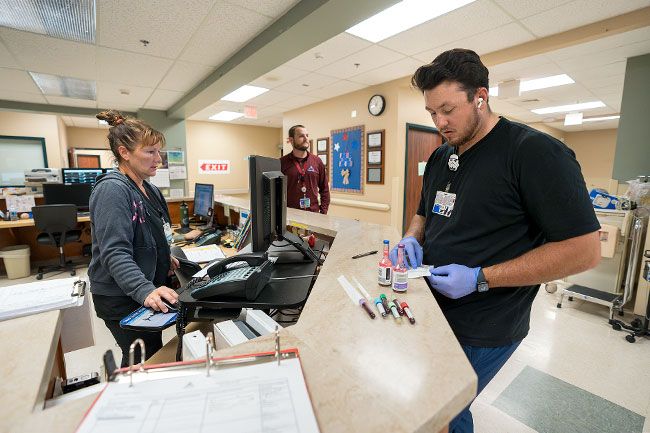
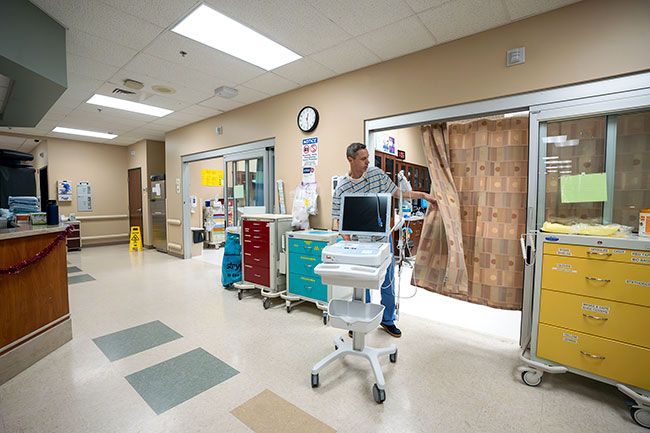
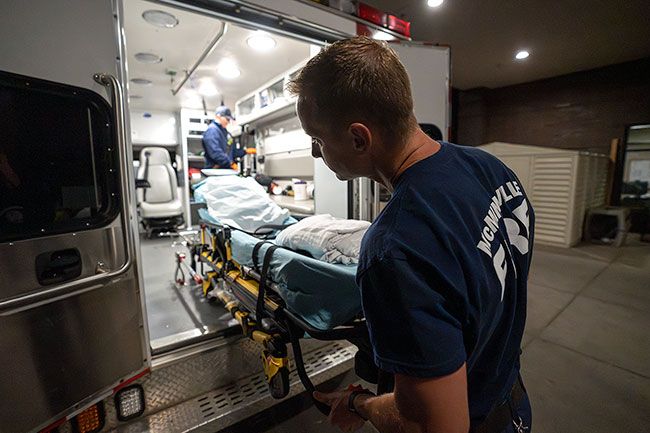
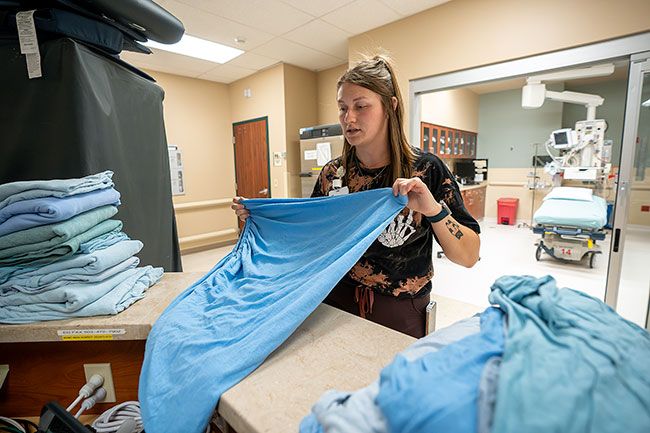
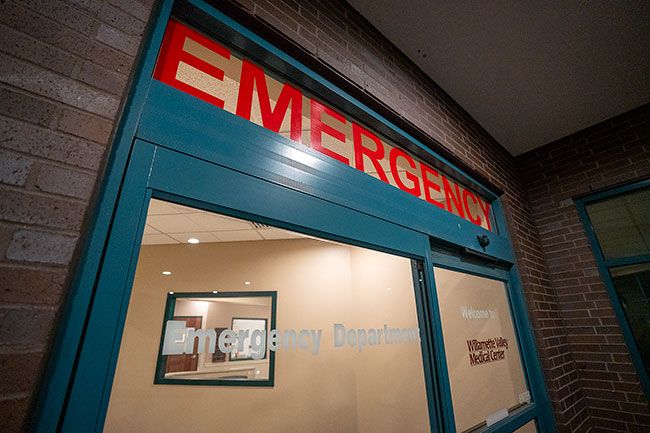
Midnight, and most of McMinnville is sleeping, or at least tucked safely at home with late night TV, Netflix or YouTube.
One resident rides through the night in an ambulance, perhaps frightened, perhaps grateful for the medical attention. Probably both.
The phone trills in the emergency room at Willamette Valley Medical Center.
Get ready, fire department medics tell ER staff. We’re bringing in someone who needs help. Here are the details. Get ready.
Nurse Sean Elliott, an Army veteran who jokes that he turned to nursing because “I can’t dance and sing,” takes the call. His voice is both matter of fact and concerned.
“OK. OK. Got it,” the RN says as he notes the information on the incoming patient’s chart. “Sounds good,” he tells the ambulance crew, and hangs up.
“What is it?” asks Connor Smith, another of the four RNs on duty in the first hour of Thursday morning, July 18.
Smith listens to Elliott’s description as the two men efficiently prepare a trauma bay for the arrival. The glass-fronted space is roomy enough for transferring a person from a stretcher to a bed, and accommodating testing equipment and half a dozen or more staff who will assist.
Outside, the moon floats above American and Oregon flags snapping in a light breeze. Traffic slides by on Highway 18, a muted parade.
Inside, the ER department is brightly lit. Patients sleep in some semi-dark rooms; family members sit beside a few beds.
Staffers talk softly, exchanging information and sometimes a joke. The stillness is broken by beeping and buzzing of monitors, the background music of the hospital.
At 12:05 a.m., pulsing red lights cut the darkness outside as the ambulance backs up to the hospital’s doors. Medics wheel in the gurney and hand over care to Elliott, Smith and Dr. Megan Dell, the physician staffing the ER tonight.
Chad Jones, an EMT and firefighter, and Amy Quinn, a paramedic, return to their ambulance to disinfect the equipment before storing it away, ready for the next call. About 12:25 p.m., they pull away from the hospital, heading back to their station.
The medics for the McMinnville Fire Department, work 24-hour shifts, one day on, then two off, followed by two on and three off. Jones said they respond to both medical and fire calls, sometimes seven to 10 in a shift, sometimes twice that many.
Inside the trauma room, CNA Emma Hall helps the patient settle in.
Hall recalls arriving at the emergency room by ambulance herself following a car wreck when she was 16. The experience inspired her to be a nursing assistant, with hopes of becoming an RN.
“I get to help and comfort people,” she says.
Unlike some arrivals, this morning’s newest patient is awake and able to answer standard questions. “Have you been coughing or had a fever? Do you have any thoughts of suicide? Are you on any medications?” nurses ask.
The answers help determine the staff’s course of action, says ER director Brandon Harris. Nurses and the doctor also rely on their own observations, notes from the ambulance crew, and tests, starting with blood pressure and temperature.
Combined, the information will help guide treatment — what comes next, how long the ER stay will be, where the person will go next.
Questioning is the initial, and routine, start of a visit to the emergency room, for both the 25% who come in by ambulance and for the majority who walk in 24 hours a day.
At the ER’s front desk, admitting rep Serena Petersen greets newcomers and asks their name, age, birthday, symptoms, etc.
She says she and her counterparts don’t ask what’s wrong, exactly. Rather, Petersen says, intake workers ask what the patients are experiencing – chest pains? Shortness of breath? Bleeding?
She also is attentive to those in the waiting room, who may be in line to be examined or, like a couple at 12:45 this morning, passing time while a loved one is being treated.
“This is never a fun place to come. It’s frightening,” Petersen says. So she asks her questions gently and patiently, putting everyone at ease with skills honed over the three-and-a-half years she’s been on the night shift.
“I like to work with the public,” says Petersen, who is on duty 7 p.m. to 7:30 a.m. for three days in a row, has one day off, three more on, then seven days off. “It’s interesting, and it’s nice to help people.”
On one of her first nights at the ER front desk, a very critical case arrived. She had to call a Code Blue, summoning an emergency response from multiple staff.
“I sounded rather frantic,” she recalls.
A more experienced coworker told her later that she needed to be more professional in order not to frighten laypeople unduly. “Never sound like I’m going down with the ship,” she was told.
So, she says, “I learned to be calm.” Quick, efficient and ready to bring about an appropriate response — and calm.
That word sums up the atmosphere in the ER: Calm, even when busy. Ready to respond to any circumstance. But calm.
From Petersen’s desk, newcomers walk or ride a wheelchair to an exam room for more questions and basic tests. Nurses listen and perform triage — assessing each person’s needs and how quickly those needs must be addressed.
The ER at WVMC is busy around the clock. But while Harris and others can tell you the average numbers per day or time of day, there’s no predicting when an ambulance actually will arrive or how severe problems will be.
Some nights pass quickly as staff members help numerous people. Some nights drag, but that gives nurses and others plenty of time to restock supplies or finish continuing education requirements — all while keeping an eye and an ear on the monitors.
Monitors sound frequently, their various tones and patterns indicating normal or elevated blood pressure or heart rates or other vital signs. Nurses don’t need to talk loudly as they share information and occasionally rib each other, like coworkers everywhere.
A lot of ER workers and EMTs hesitate to predict how busy a night may be, or even assess it while it’s happening.
“I’m superstitious,” one says.
“We don’t use the Q word,” says Petersen, the admitting rep. Saying “quiet” might jinx things, leading to a night that’s anything but.
Instead, they talk about things going smoothly: dealing efficiently with everything that happens, caring for patients promptly and effectively, making sure they bring out the best outcomes.
Training, teamwork and focus are important tools.
And, Nurse Elliott quips, “I have a four-leaf clover in my pocket.”
Time allowing, he and his colleagues do more than physical care. They show that they care about feelings, too.
Tonight is not as busy as some — the Q word could apply — so Elliott has time to talk with the new arrival a bit. He murmurs words of comfort and he listens.
“I know. You just wish you weren’t here,” he says.
Elliott says he thought of becoming a physician. A school near his Army base offered a nursing program, so he took that instead, then continued in the military as an officer for another six years.
Eventually, he says. “I thought I’d try civilian life.” He wouldn’t have minded a career in the Army, he says, but he loves nursing.
After a few minutes, Elliott leaves the room, wheeling a portable EKG heart monitor machine. “Nice person,” he tells coworkers.
He and Smith will return to the bedside from time to time as long as the patient remains in ER.
At 12:35 a.m., Jenny Root, tonight’s nurse in charge, stops to talk to her staff about the status of everyone in the department.
Root has worked at the hospital for 29 years, mostly in the ER. She chose to work nights because it was better for her family, she says. She likes the fast pace and autonomy the night shift offers.
“Over the years, it’s changed. It’s harder to find nurses who’ll work at night,” she says. “You need patience, tolerance; it can be a little more stressful. We see everything here.”
One of her goals, every night, is to provide timely care to anyone who comes into the ER. “I don’t like people waiting,” she says.
To accomplish that takes teamwork, she says. “I have a good team.”
That includes Dell, who grew up in McMinnville and returned to work at WVMC a couple years ago. The doctor also chooses to work nights and frequently is on duty in the ER
She likes the job. It can be challenging, she says, and the workload is constantly changing.
“Nights can go by very fast,” she says.
Tonight, many arrivals are older adults; another night might bring in youngsters with traumatic injuries, or adults of all ages who need detox or who are “socially challenged.”
Of the latter, she says, “I like taking care of them without judgment.”
During the busier daytime hours, more health care professionals are on duty in the ER, Harris says. The number tapers off after 11 o’clock as demand slows down.
If things get busy, though, nurses and doctors from other areas of the hospital can be called in to help during the night.
“An influx can come at any time,” Harris says.
That’s something the doctor and nurses like about working overnight. It’s as unpredictable as it is challenging.
Last night was “crazy until 5 a.m.,” for instance. Tonight is starting out with fewer cases, but who knows what 2 a.m. or 4 a.m. will bring.
“Is it a full moon? That’s the best way to predict,” Smith says.
That may prove true in a few nights. But tonight, the moon is at three-quarters and, at 1 a.m., it’s not busy.
For now.










Comments